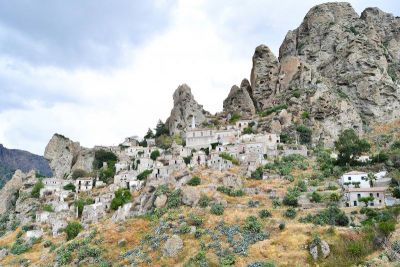Pentedattilo is a small village in Calabria, southern Italy, administratively a frazione of Melito di Porto Salvo. Until 1811, before the unification of Italy, it was a separate commune. It sits 250 meters above the sea level, on the Monte Calvario, a mountain whose shapes once resembled that of five fingers. Pentedattilo takes its name from the curious mountain shape (from the Greek pènta-darektylos, or ‘five fingers’). Pentedattilo is another ex-Greek speaking village in the isolated Calabrian region. It lost its Greek language during the late 19th century.
The town was founded as a colony of the Greek city of Chalcis, in 640 BC. A flourishing commercial town during the Greater Greece and Roman eras, it declined during the Byzantine domination, when it was sacked by the Saracens and by others.
In the 12th century, it was conquered by the Normans, and, together with Capo D'Armi, Condofuri and Montebello Ionico, it became part of a baronial fief under the Abenavoli family. These were succeeded by the Francoperta, from Reggio Calabria, and then by the Alberti (until 1760), the Clement and the Ramirez (1823).
The town was severely damaged by an earthquake in 1783, which caused the migration of much of the population to the nearby Melito Porto Salvo. The town remained totally uninhabited from the mid-1960s to the 1980s, when it was partially restored and repopulated by volunteers from across Europe.
One of the most picturesque villages in the southern Italian region, Pentedattilo has been revived by local artisans and artists who have opened wood, glass and ceramics workshops where they work and sell their products, by the opening of the Museum of Popular Traditions, and by the village’s small stone houses, surrounded by prickly pears, having been turned into hotels.
The history of Pentedattilo is said to be marked by a tragic event known as the Massacre of Alberti, which took place in 1686. Two noble families were the protagonists of the story: the Alberti, marquises of Pentedattilo, and the Abenavoli, former feudal lords of the village. The heated rivalry seemed to wane when the Baron Bernardino Abenavoli proposed to marry Antonietta, daughter of the Marquis Alberti. But Lorenzo Alberti gave his sister's hand to the son of the Viceroy of Naples, Don Petrillo Cortez. Baron Bernardino was furious about it and decided to take revenge. On the night of April 16, 1686, he entered the castle of Pentedattilo with a group of armed men and killed everyone (even Simone Alberti, Lorenzo's 9-year-old brother!) with the exception of his beloved and groom, taken in guarantee for any retaliation by the Viceroy. The Viceroy sent a real military expedition, capturing the perpetrators of the massacre, whose heads were cut and hung on the battlements of the Pentedattilo Castle. But Bernardino managed to escape, forcing Antonietta to marry him, and then abandoned her in a cloistered convent, where she finished her days consumed by the pain of having been the involuntary cause of the massacre of her family. The history of the Alberti massacre over the centuries has given rise to various legends and rumors and Pentedattilo has been repeatedly referred to as "the hand of the Devil".
Pentedattilo hosts two important festivals during the summer. Paleariza is a traveling festival that tends to enhance the tradition of the Grecanico, a particular language still spoken in the area. It touches 14 historical centers and villages of Greek Calabria through Greek language courses, theatrical performances, workshops, exhibitions, and trekking routes to show the internal areas of the territory. The Pentedattilo Film Festival is an international festival dedicated to emerging short film directors.
The vast history and revitalization of Pentedattilo lures many
visitors to its beautiful grounds.



